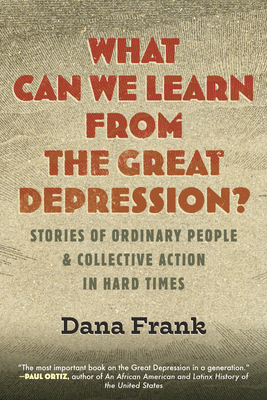What Can We Learn from the Great Depression?: Stories of Ordinary People & Collective Action in Hard Times

What Can We Learn from the Great Depression?: Stories of Ordinary People & Collective Action in Hard Times
- the 7 daring Black women who worked as wet nurses and staged a sit-down strike to demand better pay and an end to racial discrimination
- the groups who used mutual aid, cooperatives, eviction protests, and demands for government relief to meet their basic needs
- the million Mexican and Mexican American repatriados who were erased from mainstream historical memory, while (often fictitious) white "Dust Bowl migrants" became enshrined
- the Black Legion, a white supremacist fascist organization that saw racism, antisemitism, anti-Catholicism, and fascism as the cure to the Depression
While capitalism crashed during the Great Depression, racism did not and was, in fact, wielded by some to blame and oppress their neighbors. Patriarchy persisted, too, undermining the power of social movements and justifying women's marginalization within them. For other ordinary people, collective action gave them the means to survive and fight against such hostilities. What resulted were powerful new forms of horizontal reciprocity and solidarity that allowed people to provide each other with the bread, beans, and comradeship of daily life. The New Deal, when it arrived, provided vital resources to many, but others were cut off from its full benefits, especially if they were women or people of color. What Can We Learn from the Great Depression? shows us how we might look to the past to think about how we can shape the future of our own failed economy. These lessons can also help us imagine and build movements to challenge such an economy--and to transform the state as a whole--in service to the common good without replicating racism and patriarchy.
PRP: 151.20 Lei
Acesta este Prețul Recomandat de Producător. Prețul de vânzare al produsului este afișat mai jos.
136.08Lei
136.08Lei
151.20 LeiLivrare in 2-4 saptamani
Descrierea produsului
- the 7 daring Black women who worked as wet nurses and staged a sit-down strike to demand better pay and an end to racial discrimination
- the groups who used mutual aid, cooperatives, eviction protests, and demands for government relief to meet their basic needs
- the million Mexican and Mexican American repatriados who were erased from mainstream historical memory, while (often fictitious) white "Dust Bowl migrants" became enshrined
- the Black Legion, a white supremacist fascist organization that saw racism, antisemitism, anti-Catholicism, and fascism as the cure to the Depression
While capitalism crashed during the Great Depression, racism did not and was, in fact, wielded by some to blame and oppress their neighbors. Patriarchy persisted, too, undermining the power of social movements and justifying women's marginalization within them. For other ordinary people, collective action gave them the means to survive and fight against such hostilities. What resulted were powerful new forms of horizontal reciprocity and solidarity that allowed people to provide each other with the bread, beans, and comradeship of daily life. The New Deal, when it arrived, provided vital resources to many, but others were cut off from its full benefits, especially if they were women or people of color. What Can We Learn from the Great Depression? shows us how we might look to the past to think about how we can shape the future of our own failed economy. These lessons can also help us imagine and build movements to challenge such an economy--and to transform the state as a whole--in service to the common good without replicating racism and patriarchy.
Detaliile produsului










